HOW DOES FORM TAKE PLACE?

«After Altamira, all is decadence» is a paraphrasing assigned to Picasso, referring to: «Art has been in decline since the age of the caves» – an affirmation belonging to his Catalonian compatriot, the painter Juan Miro (Monforte P. F. 2021). Familiar since his youth with the decorations of the Altamira cave, Miro foresaw the spiritual and semantic richness of prehistoric painting, thoroughly studied by paleoanthropological research. Humans orient themselves and communicate with each other primarily by visualization. The study of prehistoric art shows that vision is not simply our principal sense – it is the sensorial foundation for the communicational integration of the other senses or sensorial modes. The research in the prehistoric art domain shows the multi-modal unity and complexity of its masterpieces by using:
• Acoustical effects obtained through reverberations of sound waves caused by the natural relief of cave walls (I. Reznikoff I. 2008, 2010; Waller S. J. 1999/2002, 2002); • Effects of pareidolia in the pre-visualization of animal figures through the illusory visual effect of natural relief of cave walls (Gourhan A. L. 1982; Hughes F. 2021);
• The illusory animation of animal figures, obtained by lightning direction applied to areas of repeating profiles of partially or full body parts (Azema M. 2012);
• The synchronization of graphic signs and painted figures of caves with the astronomical and celestial landmarks on the interior cave walls (Rappenglück R. A. 2004; Jegues-Wolkiewiez C. 2011, 2013);
• The signs and figures had a symbolic message with an ethological profile (interpreting the animal behavior as a social model for humans) narratively developed in the communicational-linguistic and cognitive embodied space of the cave (Azema M. 2008; Boroditsky L. & Gaby A. 2010; Núñez R., et al., 2012).
All these multi-modal and structural effects and their significance competed at the concretization of a total experience, attractive from a cultural and participative point of view and relevant as lived experience at the level of the entire social community.
The apparition of „table-painting” in Occidental Europe of the 15th century took place together with the detachment of iconographic retables from the assemble of churches’ altarpiece, by personalization of painted scenes like Sacra conversatione and, in general, by isolating the painting against the institutional architectural framework, to become personal goods of his patron. Addressing the problem of „table-painting” involves the following structural issues:
• The use as support of white and plate surfaces that sustain the lucrative traces exposed in uniform ambient light with static source;
• „Table-painting” is a mobile object, namely, deprived by attachment against an exterior context;
• The lucrative traces generate a static image on the visual field of the viewer’s eye.
To begin a work of art under these circumstances equates with a great plunge into the unknown. The egocentric nature of author and viewer reference to the working object – spatially remote from a cognitive-embodied and cultural point of view – asks an effort of reintegration from the socio-ecological landmarks, which often, the author (or the potential author) refuses to assume in painting. If you are a sculptor, the plasticity of clay or the solidity of the rock listens to you, or if you are an architect, gravitational attraction and the resistance of materials listen to you. As a painter, visual form has to listen to you. Where does the visual form come from? How can you model it? What laws follow the modeling of visual form? Even without knowing the answers to these questions, we can intuitively assume that they would remain a perpetual unknown from an exterior or physical point of view. Any lucrative trace marked by the author on the inert support of the table–painting becomes a screen that overtakes in rigidity and opacity, even the most solid rock. The viewer must learn to understand the structural and spatial essence of visualizing the lucrative trace led by the author. It is what I’m going to clarify in this presentation by deepening the dynamics of composed surfaces from the point of view of non-chromatic properties and relations.
Presenting the chromatic system, we established the following principles of modeling:
• The neurobiological support of the system, which establishes its scientific argument;
• The quantitative categorization of properties’ parameters, which has a synthetic and comparative mathematical nature, not a replicative and absolute one;
• The direct application of systemic relations, which proves its pragmatic modeling.
Also, in the metaphysical presentation of visual form, I localized the neural processing of visual form at the superior levels of perception and cognition, where the space is not an external visual stimulus but an internal context established between the structural properties of perceptive targets and objects visualized within the cognitive maps. We can achieve chromatic relations based only on the parameters of color mixing or gradient in the chromatic system. By difference, form modeling involves the spatial contextualization of chromatic and non-chromatic spatially attentive properties. Therefore, we can consider the following types of modeling:
• Systemic, where relations between at least two properties take place, resulting in categories of parameters;
• Constructive-systemic, which establishes relations at the level of isolated or localized surfaces, transformative declined and categorized on base of comparative parameters of their properties;
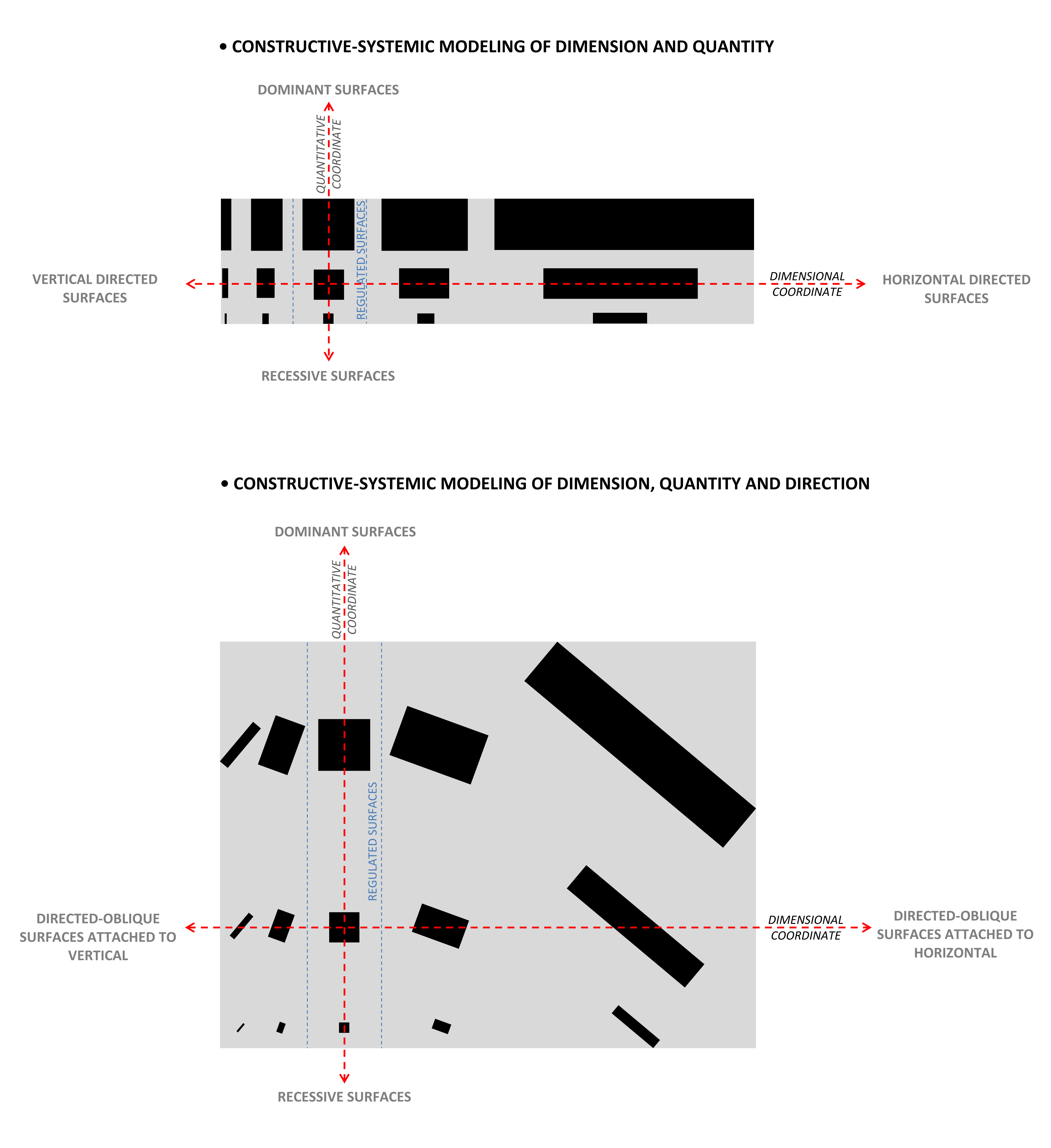
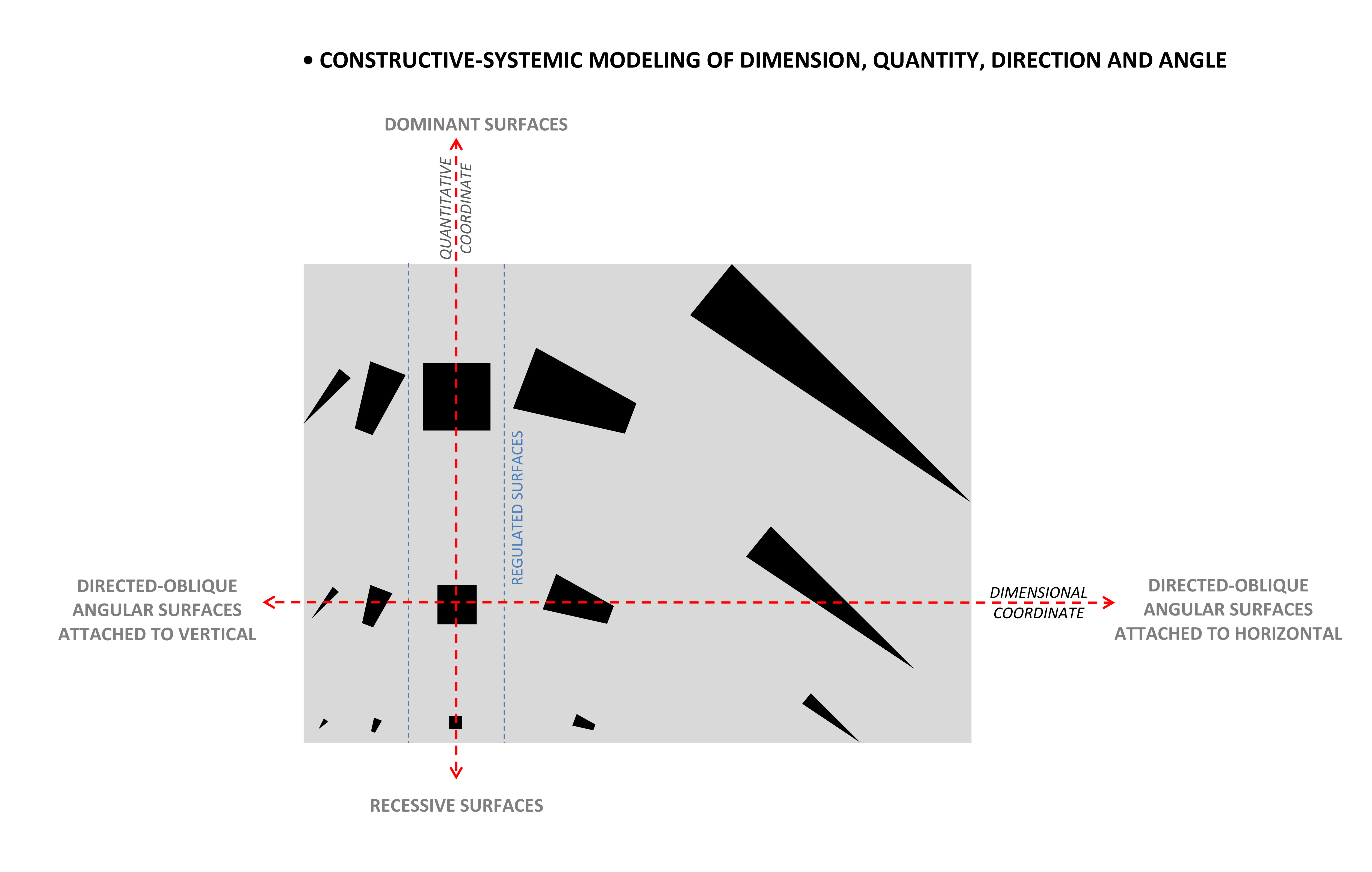
• Morpho-constructive, by which surfaces with their transformative potential are assembled for attentive prominence of the morphological object against the morphological background according to some properties of spatial contextualization.
From a perceptive-ecologic point of view, the process of human visualization, as the one evolutionary–related of primates, helps to the recognition of objects under cinematic imagistic conditions that have a stable optic center of the visual field around whom takes place the optic flux made of vectors of movement convergent or divergent related to the optical center (Gordon I. E. 1989; Gibson J. J. 1986). We will adapt the cinematic vector model to the apparent dynamic of static image space. For this reason, the static vector renders the following non-chromatic properties:
• The size, which marks the distance between the point of application and the final point of stopping the mobile;
• The direction, which marks the trajectory of the mobile road;
• The sense that marks the place towards which the mobile is heading within the direction of the vector.
From the cinematic point of view, we must add speed and acceleration of the mobile, but we can't consider them related to the composition of a static image.
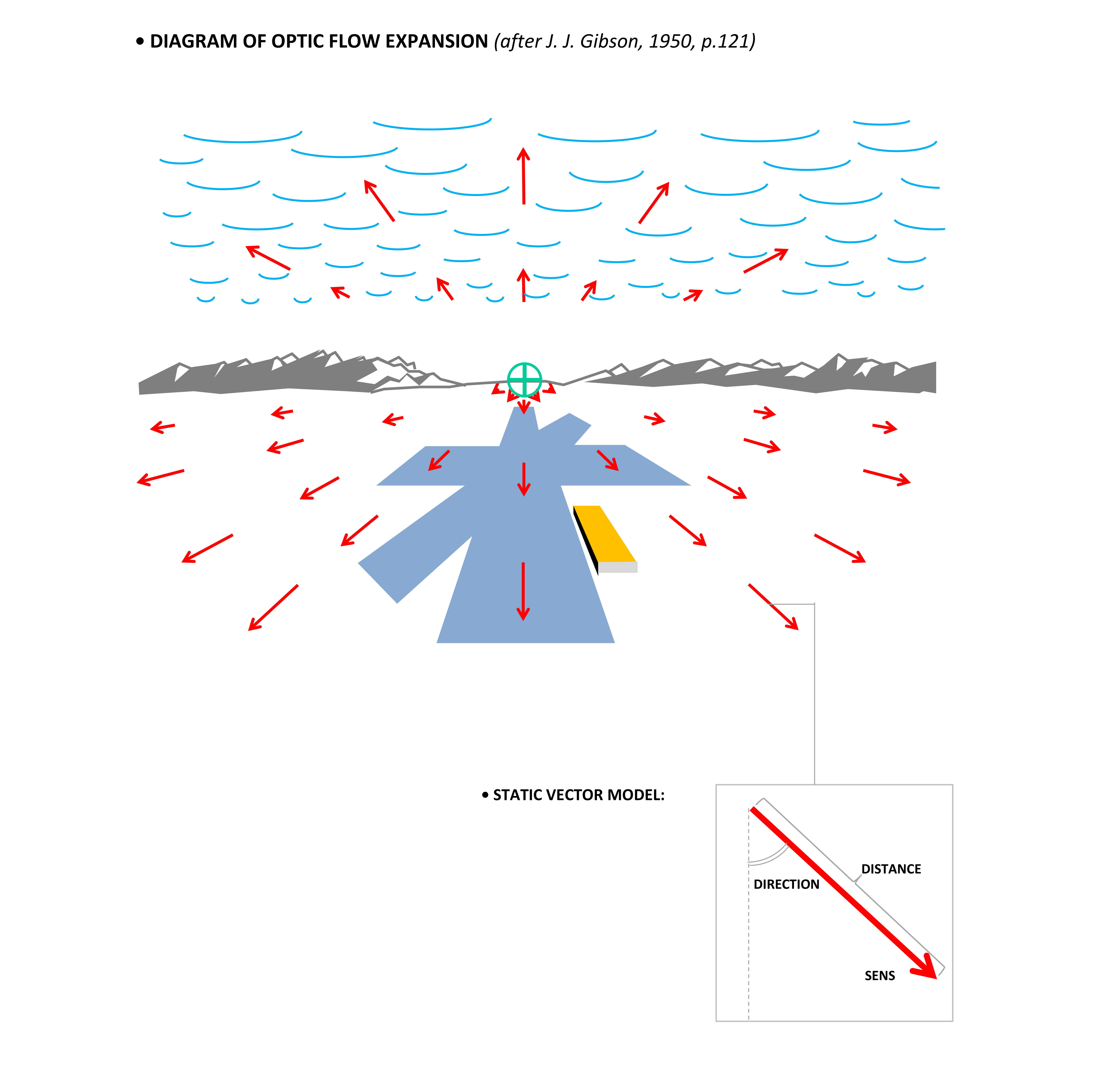
I must mention that what I call surface or constructive surface is synonymous with the notion of form, shape, perceptive object, or target in the scientific literature. The authors use the form with the meaning of a geometric figure or isolated surface detached against the background, seen as componential unity between content and contour, not as morphological contextualization of the object on a background.
The neurobiological support generates and relates the properties that originate in the primary visual area (V1), placed in the center of the occipital lobe, where the neural visual channels via geniculate lateral nuclei arrive from the retina (Milner A. D. 1998; Purves D., et al., 2018; T. Huff, et al., 2023). Also, V1 is the origin of the two visual pathways with a perceptive-cognitive character, as follows:
• The ventral pathway, which encompasses the inferior zone of the temporal lobe, is covered predominantly by the neural channels that arrive from the parvocellular system of geniculate nuclei with a role in processing the recognition of objects (B. R.Sheth & R.Young 2016);
• The dorsal pathway, which encompasses the posterior zone of the parietal lobe, is covered predominantly by neural channels that arrive from the magnocellular system of geniculate nuclei with a role in processing the movement of objects (Righi G. & Vettel J. 2018).
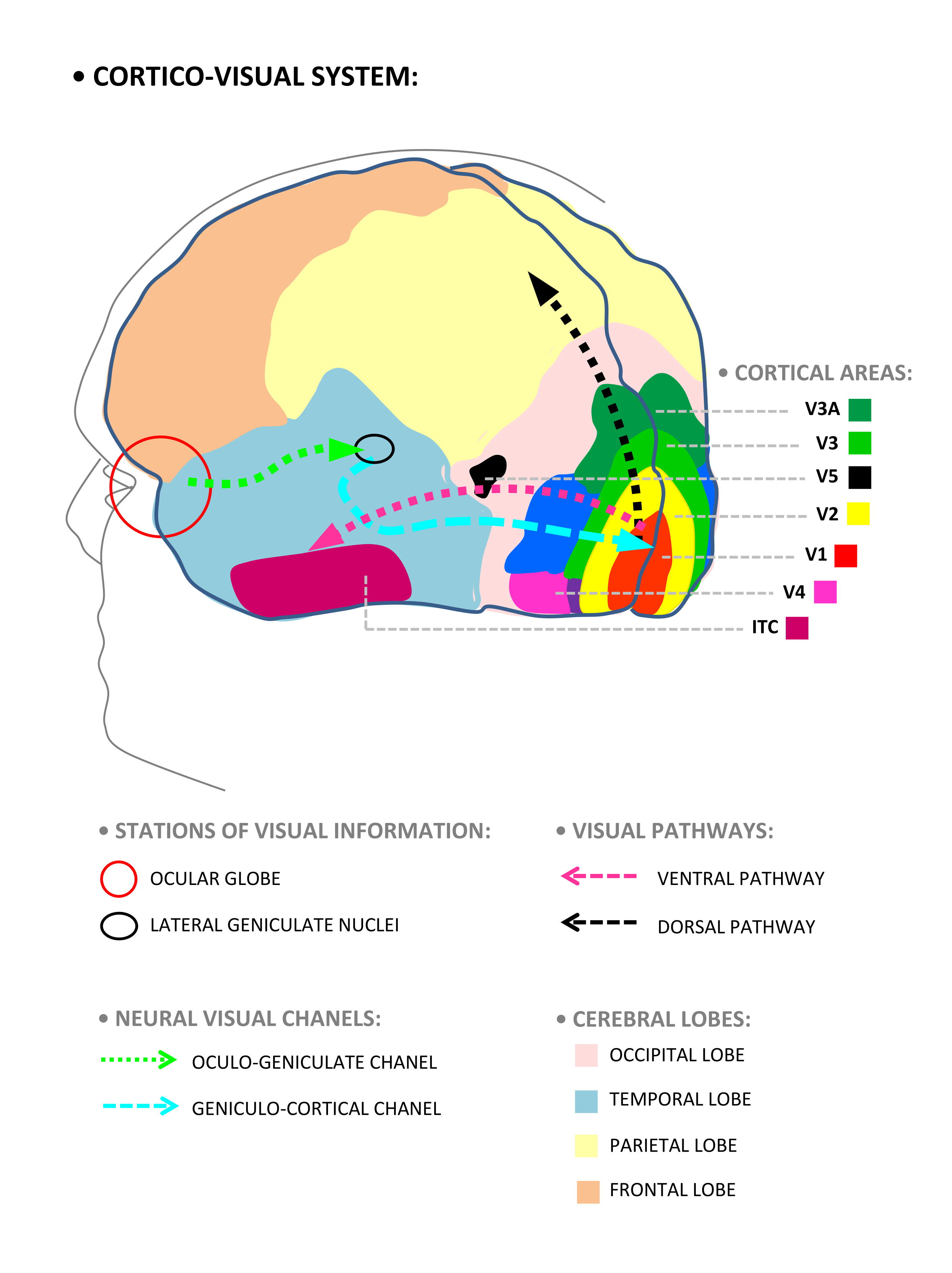
Modeling non-chromatic properties and their relations requires the hierarchical model of cortical visual area connection (Kafalıgönül H. 2014; Yamasaki T. & Tobimatsu S. 2014). They encompass the following types of connections: • As parallel series, when consecutive areas with common origin connect in unique succession; • As a bypass, when an area connects directly with the origin, passing over the intermediary consecutive areas from the series; • As a transverse connection, when two areas from two parallel series connect at the same hierarchical level.
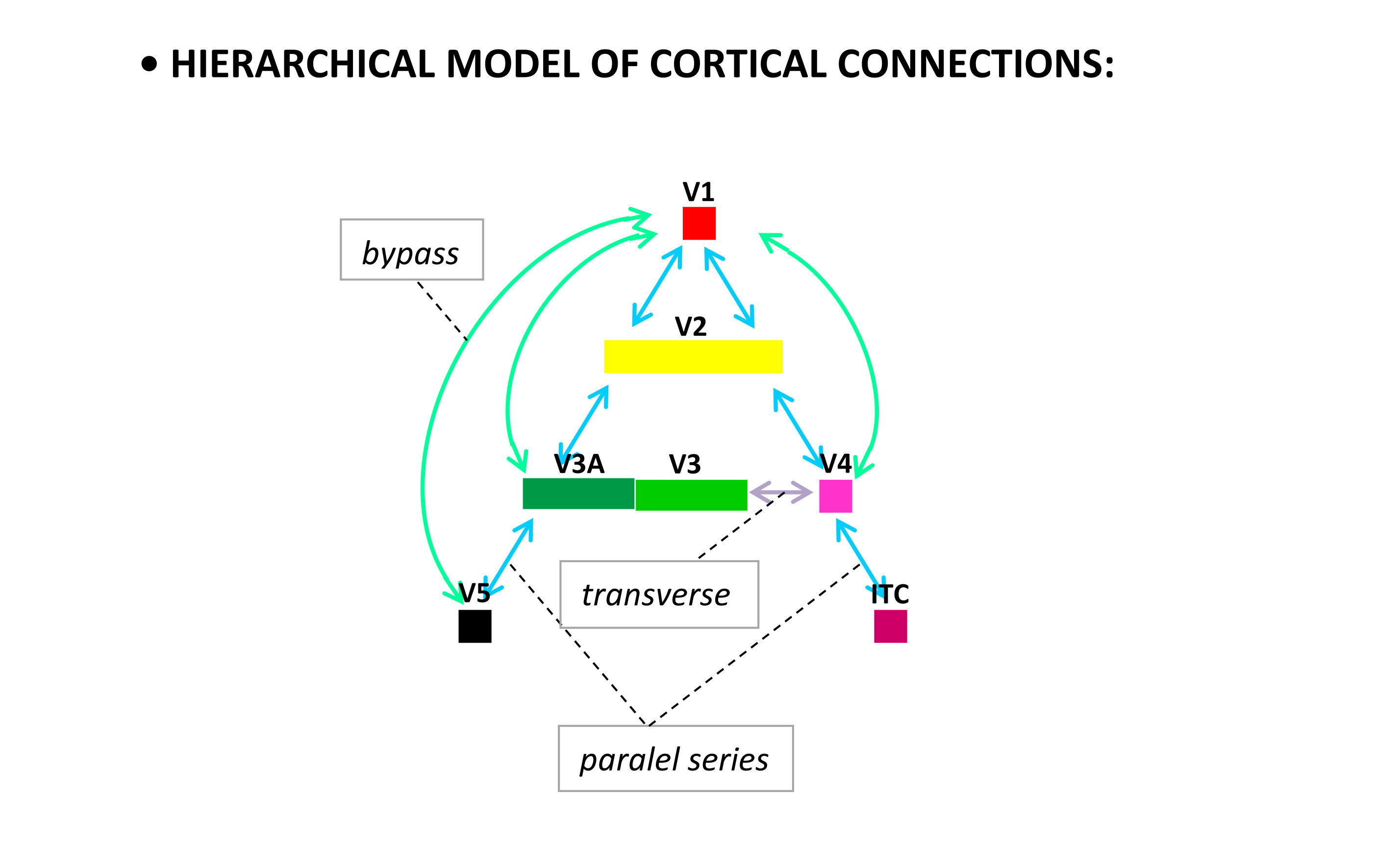
Without going into neuro-combinatorial details of hierarchical connections, I must specify that in the structural research of static images, the neuro-cognitive processes of the ventral pathway have the prevalent role in constructive and systemic modeling of a-chromatic properties, which concern the constructive components of isolated or local surfaces (Ayzenberg V. & Behrmann M. 2022), detached from the background; it is why the pathway is named what stream. The relations associated with the models of morphological dynamics will be argued by referring to neuro-connections developed across the dorsal pathway, called the where stream because it implies the contextualization of objects against the background. Those are the landmarks we will consider in exploring non-chromatic properties.
DIRECTION AND SIZE
Considering the adaptation of the ecological model of the static vector to the composition of static images, the main non-chromatic properties peculiar to the compositional surfaces are the direction and the size. The neural processing of constructive components of isolated and static surfaces – the contour and the content – takes place as direction as follows:
• By detachment (isolation or cropping) of the object against the background, experimentally highlighted by the EFFECT OF COLLINEAR MASKING, processed at the level of primary visual area (V1) (Chow H.M., et al., 2013 2015, 2016; Jingling L. 2013, 2017; Tseng C. & Jingling L. 2013, 2015; Zhaoping L. & Dayan P. 2006; Ng J., et al.,2007);
• By identifying, selecting, and categorizing the linear contour of isolated surfaces based on the OBLIQUE EFFECT (perpendicularity) and SYMMETRIZATION, processed at the level of primary visual area (V1) (Furmanski C. & Engel S. 2000; Li B., et al., 2002), respectively, at the level of area V3 (Keefe B. D., et al., 2017; Bertamini M., et al., 2018);
• By identifying and dimensional categorization of the unity between the constructive components of the surface as regulated (centered) or directional (linearized), vertical or horizontal, at the processing level of inferotemporal area (IT or TE) (Tanaka K. 1997; Riesenhuber M. & Poggio T. 1999).

The areas V1 and V2 and the ventral portion of V4 area process THE CHROMATIC CONTENT of isolated surfaces (Roe A. W., et al., 2012), while cortical area V4 processes SIZE CONSTANCY (Tanaka S. & Fujita X. 2015). The synchronization between the size, direction, and identification of extensive constructive surfaces will be the subject of the future presentation, where I will apply the constructive and morphological models of non-chromatic properties.
SENSE
Although the static image does not allow from the point of view of physical representation of mapped surfaces only manifestations of size and direction, we can deduce the sense also from the VARIATIONS OF SIZE and distance, area or angular orientation of linear delimitations of surfaces, intersected in fixed point. The variations create the morphological distinction between the object and background because the sense is a consequence of size variation related to background surfaces against the constant size of the surface of the morphological object (rectilinear model). However, the sense can be an alternation of content size between the surfaces of the morphological background with angular delineation, where the angular tip is the constructive component with the function of the morphological object (trctangular and angular model). The sense is not processed at the level of the ventral pathway because of its complex and dynamic structure, even if we deduce it from static images. The visual effect by which we establish the sense in static images is THE IMPLIED MOTION, processed within the visual area V5 because of a bypass connection with the primary visual area (V1) (Kim C.-Y. & Blake R. 2007; Pavan A., et al., 2011; Zeki S. 2015; Krekelberg B., et al., 2005).
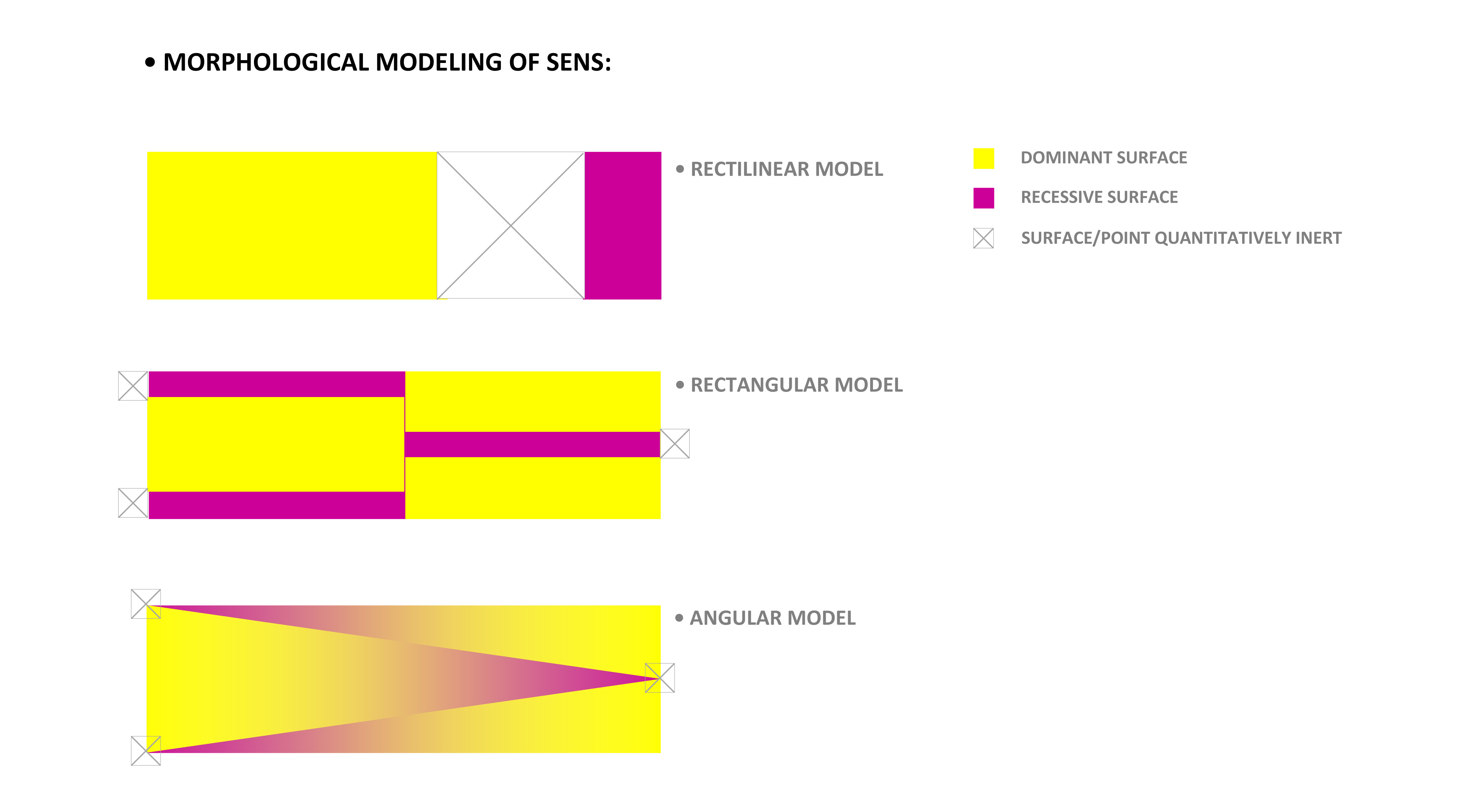
POSITION
The property with the highest degree of contextual and morpho-compositional synthesis is the position of the morphological object. The position appears within a visual form by the topological symmetrization of constructive components sustained by the V2 area against the dynamic or asymmetric sense set-up of the V5 area. The position contextualizes the morphological object, relating it to other visual forms (morphological registers or stripes) of inferior and superior size. The object position is the finality of condescending visual forms within an iterative or recurrent and finite series – not infinite, as in the case of fractal iteration – where the module is the form. Positioning the morphological object shows us that the morphological and modular – or rhythmic – dimensionalization of composition has an exponential character that is:
• A-dimensional – at the level of objectual connections between forms or iterations;
• Mono-dimensional – at the level of the collinear unfolding of constructive components;
• Tri-dimensional – at the level of depth browsing by iterative recurrence of compositional forms.
The result is a trans-morphological positioning of the morpho-attentive object because, within a superior iteration, a morphological component becomes the component of another form, and, within an inferior iteration, a morphological component becomes the frame of a form that includes new morphological components. Iterations can be collinear or non-collinear with directly related iterations. Selective attention is the internal process that sustains the recurrent character of morpho-iterative composition (Moore T. & Zirnsak M. 2017). In the future, we must clarify its actual neural support from the point of view of scientific documentation. We must find in the literature the stimulatory models suited for our recurrent model because the ones used in experiments generate other various neural reactions. But we can assume that, in the case of visualizing simple surfaces within a static image with a mobile character, the selective attention would be determined by:
• Top-down neural processes are endogenously generated as a result of a pre-imposed rule of selection that, in the case of iterations, is the recurrence of forms;
• Covert character of attention occurs when the brain is processing the information in the absence of any ocular movement of eye orientation on behalf of a static stimulatory object;
• The spread and restriction of attention derived from discrete compositional segmentation, delineable and finite, of morphological registers or stripes with their components.
In conclusion to the presentation of non-chromatic properties, we can assemble the morpho-compositional diagram of the image of the examined work of art based on the comparative expression of parameters as non-chromatic quantitative categories, as follows: • The size corresponds to the parameters of recesivity-dominance; • The dimensionalization of the surface corresponds to the parameters of regularity-directionality;
• The sense of the object corresponds with the vector parameters adapted to the direction of form, as follows: for the horizontal direction, we have left-right, and for the vertical direction, we have up-down;
• The position, even if related to the symmetrization of the constructive components of surfaces within a form, corresponds to central-lateral parameters; because of the trans-morphological localization of the object within the composition, we must express the position by the chaining of condescending iterations with their morphologic components and their properties that result in the morphological diagram of the composition.
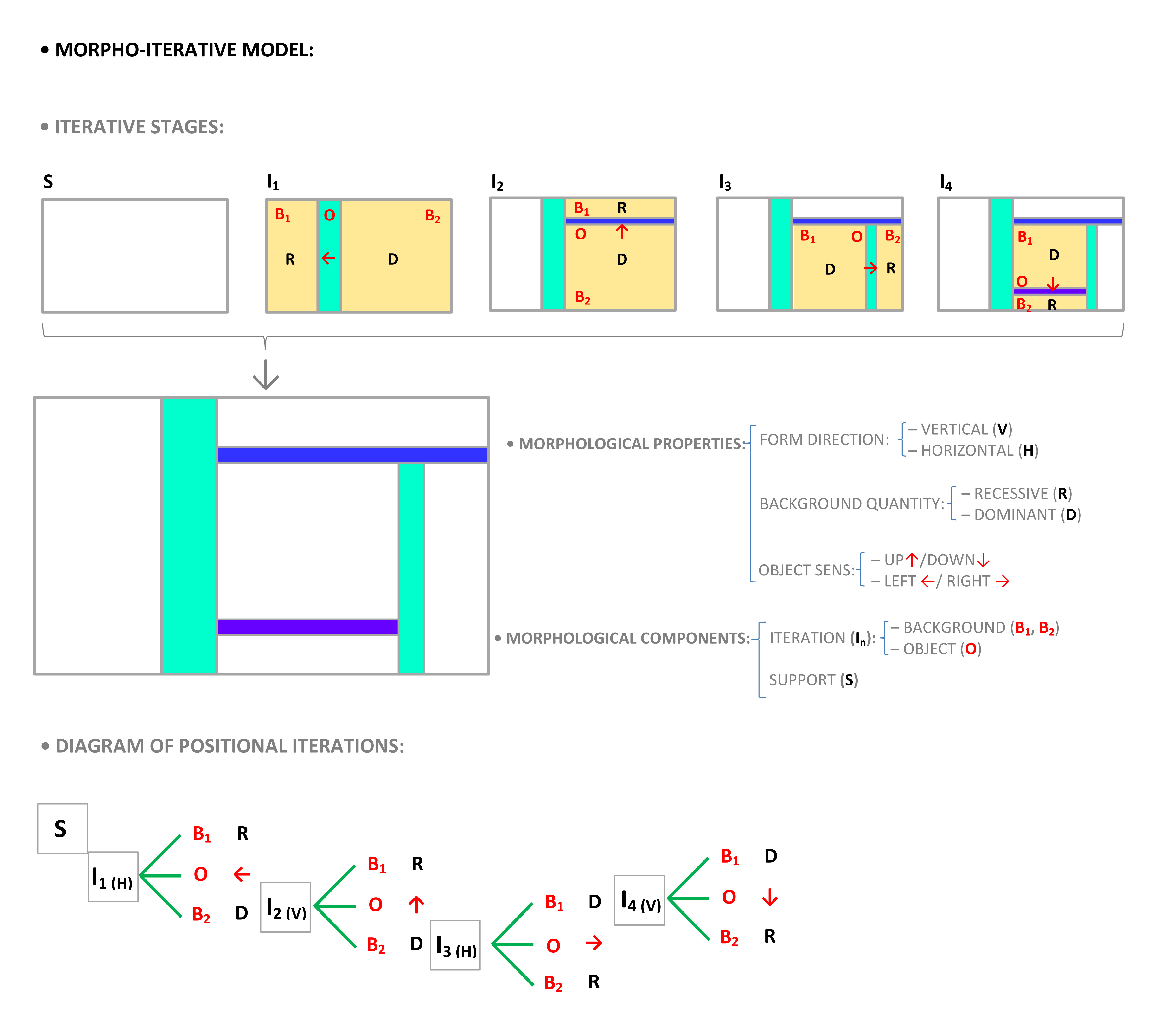
From the conceptual point of view, finding the morphological sense and iterative position of the morpho-attentive object points to the synthesis and the essentialization, or the abstraction of the compositional structure of an image. Sense and position solve the hierarchy of interest centers, the total inter-dependency of constructive components – each with its morphological function, and the compositional balance due to the opposition of sense of the objects inside the forms contained by distinct iterations.
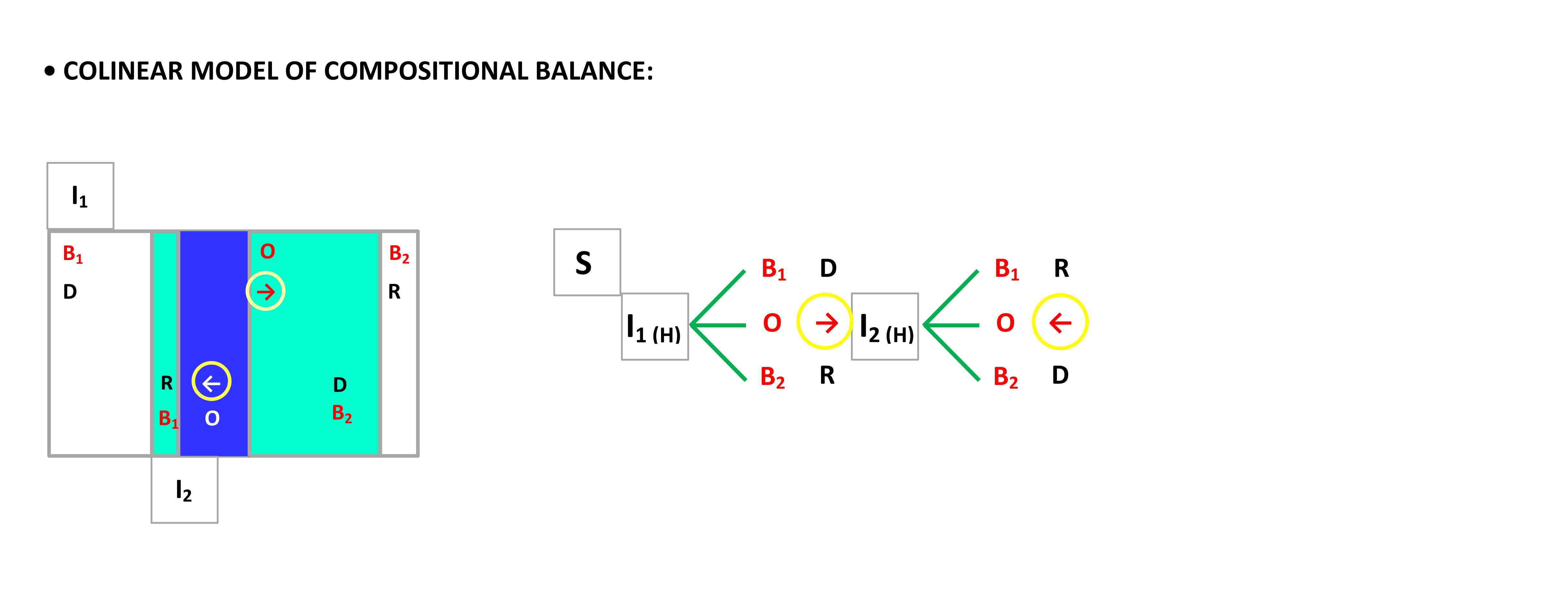
Also, to the extent that the form is a spatial phenomenon that appears in the visual consciousness, we can establish a correspondence between the hierarchical cortical processing of visual information and the stages of phenomenological reduction, as follows:
• THE INTUITIVE STAGE would correspond to the detachment of the perceptive target against the background at the level of primary visual area (V1) because it does not depend on complex relations and properties, only on an effect of prominence by contrast and COLLINEAR MASKING;
• The stage of UNIFYING and SYNTHETIC THINKING would correspond to the hierarchical stages of cortical constructive processing of properties and relations of surface components, becoming more and more extensive toward the recognition and description of local surfaces;
• THE PARTICIPATIVE STAGE of apparition and development of visual morphological phenomenon would be similar to the processing of IMPLIED MOTION and SELECTIVE-ATTENTIVE positioning of the object morpho-dynamically integrated.
These matches remain just mere analogies because, at this moment, we have only cognitive-embodied (Parvizi J. & Damasio A. 2001; Damasio A.& Meyer K. 2009) and neuro-physical theories (Penrose R. 1994, 2017) about the concept of consciousness related to human neural activity.
Another apparent deficiency in the structural research method would be the joining of scientific-experimental results with the phenomenological reductive method, resulting in an improper naturalism for the transcendental aspirations of phenomenology. The Kantian argument (Motorina L. E.) would be that the unicity of human experience within each scientific experiment is contrary to the determination of generally valid truths that fail into the scope of the apriority – the base of direct a-posterior experience. Anyway, in visual perception, the development of statistical methods of stimulatory models simplification by provoking punctual-quantifiable reactions and the perfection of visualizing technologies of neural processes limit the subjective intervention of the experimenter on the results and conclusions of his experiments and brings him closer to some aprioristic horizons recovered in theories with holistic character (Treisman A. & Gelade G. 1980; Pylyshyn Z. W. 2003). It is why we can conclude that the role of the phenomeno-logical method is not to determine generally valid truths or objective-scientific experimental results but to facilitate the customization of these results at the level of structures with an accentuated character of unicity or originality, like in the case of visual works of art (Denison R. N., Block N. & Samaha J. 2022). Thus, we can use the scientific method and the phenomenological one in a complementary way in the research of visual works of art.
REFERENCES:
Ayzenberg V. & Behrmann M. 2022. – Does the brain's ventral visual pathway compute object shape? Trends in Cognitive Sciences, Month, Vol. xx, No. Xx.
Azema M. 2008. – Representation of movement in the Upper Palaeolithic: An ethological approach to the interpretation of parietal art. Anthropozoologica 43: 117-154.
Azema M. & Florent R. 2012. – Animation in Palaeolithic art: a pre-echo of cinema. ANTIQUITY 86: 316–324.
Bertamini M., Silvanto J., Norcia A. M., Makin A. D. J. & Wagemans J. 2018. – The neural basis of visual symmetry and its role inmid- and high-level visual processing. Annals of the New York Academy of Sciences 1426: 111–126.
Boroditsky L. & Gaby A. 2010. – Remembrances of Times East: Absolute Spatial Representations of Time in an Australian Aboriginal Community. Psychological Science21(11): 1635 –1639.
Chow H.M., Jingling L. & Tseng C. 2013. – Collinear integration affects visual search at V1. Journal of Vision 13(10):24: 1–20.
Chow H.M.& Jingling L. 2015. – A Salient and Task-Irrelevant Collinear Structure Hurts Visual Search. PLoS ONE 10(4): e0124190. doi:10.1371/journal.pone.0124190.
Chow H.M., Jingling L. & Tseng C. 2016. – Eye of origin guides attention away: An ocular singleton column impairs visual search like a collinear column. Journal of Vision 16(1):12: 1–17.
Damasio A. & Meyer K. 2009. – Consciousness: An Overview of the Phenomenon and of Its Possible Neural Basis, în Laureys S. & Tononi G. (ed.) The Neurology of Consciousness: Cognitive Neuroscience and Neuropathology. Academic Press: 3-14.
Denison R. N., Block N. & Samaha J. 2022. – What Do Models of Visual Perception Tell Us about Visual Phenomenology?, in Brigard F. D. & Armstrong W. S. (ed.) Neuroscience and Philosophy. Cambridge, Massachusetts : The MIT Press: 241–284.
Furmanski C. & Engel S. 2000. – An oblique effect in human primary visual cortex. Nature Neuro-science / volume 3, no 6 / june.
Gordon I. E. 1989. – Theories of Visual Perception. Wiley: 148.
Gibson J. J. 1986. – The Ecological Approach to Visual Perception. Psychology Press. Gourhan A. L. 1982. – The Dawn of European Art: An Introduction to Palaeolithic Cave Painting. Cambridge University Press, Cambridge [Cambridgeshire]: 9.
Huff T, Mahabadi N, Tadi P 2023. – Neuroanatomy, visual cortex,în: StatPearls. Treasure Island (FL): StatPearls Publishing. Available at: https://www.ncbi.nlm.nih.gov/books/NBK482504/ [Accessed March 16]. Hughes F. 2021. – Relief and the Structure of Intentions in Late Palaeolithic Cave Art. The Journal of Aesthetics and Art Criticism 79: 285–300.
Jegues-Wolkiewiez C. 2011. – The Relationship between Solstice Light and the Entrance of the Palaeolithic Painted Caves, in Gheorghiu D. (ed.) Archaeology Experiences Spirituality? Cambridge Scholars Publishing; Unabridged edition (December 1): 11-50.
Jegues-Wolkiewiez C. 2013. – L'Ethnoastronomie : Nouvelle appréhension de l'Art préhistorique. Antipode-Editions du Puits de Roulle. Jingling L. 2013. – The configuration effect in visual search. Article in Journal of Vision · July.
Jingling, L., Lu, YH., Cheng, M. & Tseng C 2017 . – Collinear masking effect in visual search is independent of perceptual salience. Atten Percept Psychophys 79, 1366–1383.
Keefe B. D., Gouws A. D., Sheldon A. A., Vernon R. J. W., Lawrence S. J. D., McKeefry D. J., Wade A. R. & Morland A. B. 2017. – Emergence of symmetry selectivity in the visual areas of the human brain: fMRI responses to symmetry presented in both frontoparallel and slanted planes. Human Brain Mapping Published by Wiley Periodicals, Inc.
Kim C.-Y. & Blake R. 2007. – Brain activity accompanying perception of implied motion in abstract paintings. Spatial Vision, Vol. 20, No. 6: pp. 545–560.
Krekelberg B., Vatakis A. & Kourtzi Z. 2005. – Implied Motion from Form in the Human Visual Cortex. PresS. J Neurophysiol (August 17).
Li B., Peterson M. R. & Freeman R. D. 2002. – Oblique Effect: A Neural Basis in the Visual Cortex. Journal of Neurophysiol, Vol. 90, July: 204 –217.
Milner A. D. 1998. – The Visual Brain in Action. Oxford Psychology Series, No. 27, Oxford University Press: xvii - 248.
Moore T. & Zirnsak M. 2017. – Neural Mechanisms of Selective Visual Attention. Annu. Rev. Psychol 68: 47-72.
Monforte P. F. 2021. – The Cave of Altamira and the Modern Creation, in Hampson J. & Rozwadowski A. (ed.) Visual Culture, Heritage and Identity: Using Rock Art to Reconnect Past and Present: 24-36.
Motorina L. E. 2014. – Concept of Sciencein Kantian Philosophy. Studia Philosophica Kantiana 1, 2 0 1 4. Ng J., et al., 2007. – A Survey of Architecture and Function of the Primary Visual Cortex (V1). Hindawi Publishing Corporation, EURASIP Journal on Advances in Signal Processing, Article ID 97961.
Núñez R., Cooperrider R., Doan D. & Wassmann J. 2012. – Author's personal copyContours of time: Topographic construals of past, present, and future in the Yupno valley of Papua New Guinea. Cognition 124: 25–35.
Parvizi J. & Damasio A. 2001. – Consciousness and the brainstem. Cognition 79: 135-159.
Pavan A., Cuturi L. F., Maniglia M., Casco C., Campana G. 2011. – Implied motion from static photographs influences the perceived position of stationary objects. Vision Research 51: 187–194.
Penrose R. 1994. – Shadows of the Mind: A Search for the Missing Science of Consciousness. Oxford University Press, London.
Penrose R. 2010. – Consciousness and the Universe: Quantum Physics, Evolution, Brain & Mind. Cosmology Science Publishers.
Purves D., Augustine G. J., Fitzpatrick D., Hall W. C., LaMantia A.-S., Mooney R. D., Platt M. L., White L.E. (ed.) 2018. NEUROSCIENCE, Sixth Edition. Oxford University Press: 261-280.
Pylyshyn Z. W. 2003. – Seeing and VisualizingIt's Not What You Think. The MIT Press.
Rappenglück R. A. 2004. – A Palaeolithic Planetarium Underground—the Cave of Lascaux (Part. 1), in Migration & Diffusion, Vol. 5, Issue Number 18: 93-119.
Reznikoff I. 2008. – Sound resonance in prehistoric times: A study of Paleolithic painted caves and rocks. Acoustics 08 Paris: 7179-7183.
Reznikoff I. 2010. – La Dimension Sonore des Grottes Préhistoriques à Peintures. 10ème Congrès Français d’Acoustique, Apr 2010, Lyon, France. hal-00534626.
Riesenhuber M. & Poggio T. 1999. – Hierarchical models of object recognition in cortex. Nature Neuroscience, Vol. 2, No. 11, November: 1019=1025.
Righi G. & Vettel J. 2018. – Dorsal Visual Pathway. Encyclopedia of Clinical Neuropsychology pp 1214–1216.
Roe A. W., L. Chelazzi, Connor C. E., Conway B.R., I. Fujita I., Gallant J. L., Lu H. & Vanduffel W. 2012. – Toward a Unified Theory of Visual Area V4. Elsevier Inc., Neuron Review 74: 12-29.
Sheth B. R. & Young R. 2016. Frontiers in Integrative Neuroscience, Volume 10, Article 37.
Tanaka K. 1997. – Mechanisms of visual object recognition: monkey and human studies. Current Opinion in Neurobiology 7:523-52.
Tanaka S. & Fujita X. 2015. – Computation of Object Size in Visual Cortical Area V4 as a Neural Basis for Size Constancy. The Journal of Neuroscience, August 26, 35(34):12033–12046.
Treisman A. & Gelade G. 1980. – A feature-integration theory of attention. Cognitive Psychology, 12 (1), pp. 97–136.
Tseng C.& Jingling L. 2013. – Collinearity Impairs Local Element Visual Search. Journal of Experimental Psychology: Human Perception and Performance. doi: 10.1037/a0027325.
Tseng C.& Jingling L. 2015. – A Salient and Task-Irrelevant Collinear Structure Hurts Visual Search. PLoS ONE 10(4): e0124190.
Waller S. J. 1999-2002. – Rock Art Acoustics in the Past, Present and Future. 1999 International Rock Art Congress Proceedings 2: 11-20.
Waller S. J. 2002. – Psychoacoustic influences of the echoing environments of prehistoric art. The Journal of the Acoustical Society of America 112: 2284.
Yamasaki T. & Tobimatsu S. 2014. – Electrophysiological biomarkers for improved etiological diagnosis of cognitive impairment. Dovepress Journal, Current Biomarker Findings 4: 69–79.
Zeki S. 2015. – Area V5—a microcosm of the visual. Frontiers in Integrative Neuroscience, April, Volume 9, Article 21.
Zhaoping L. & Dayan P. 2006. – Pre-Attentive Visual Selection. Neural Networks, Volumn 19, Number 9, Nov.: 1437-1439.